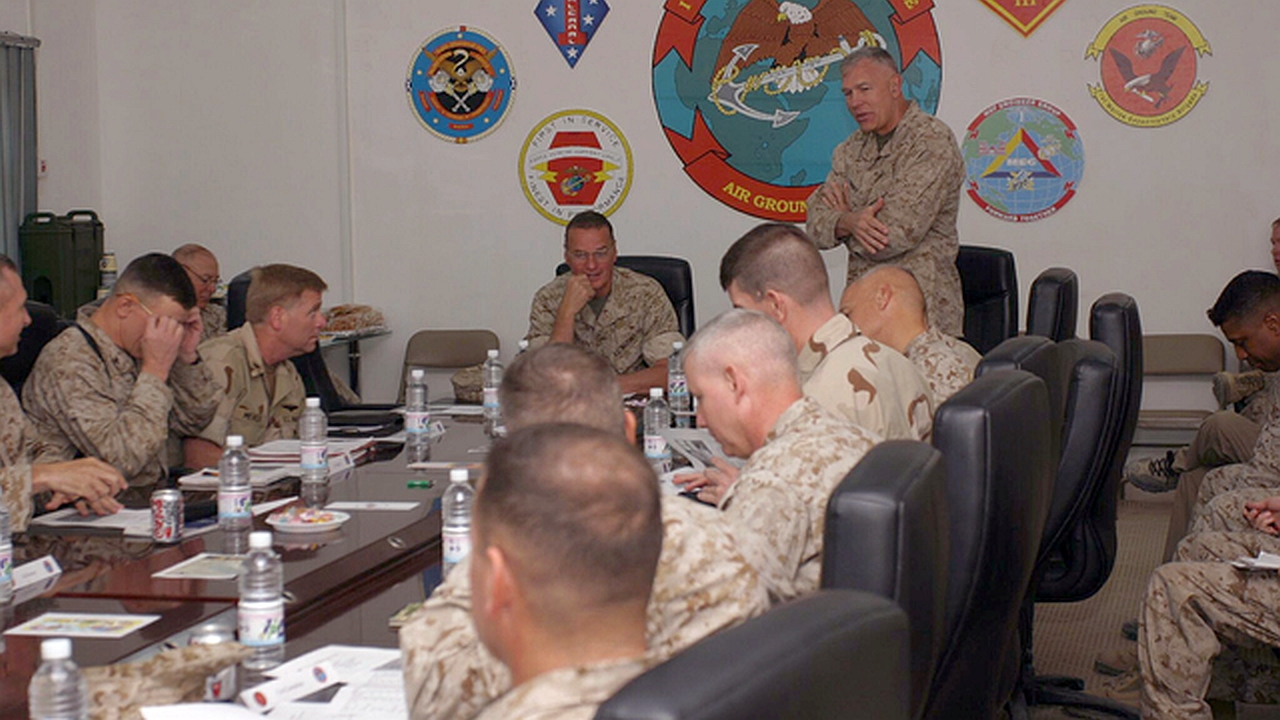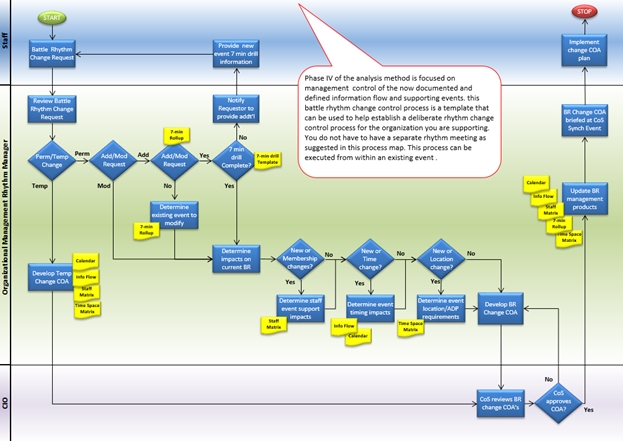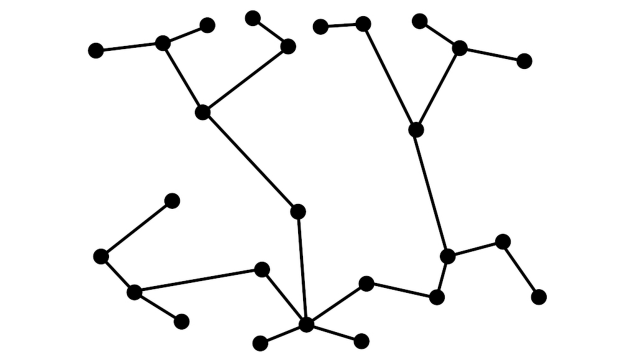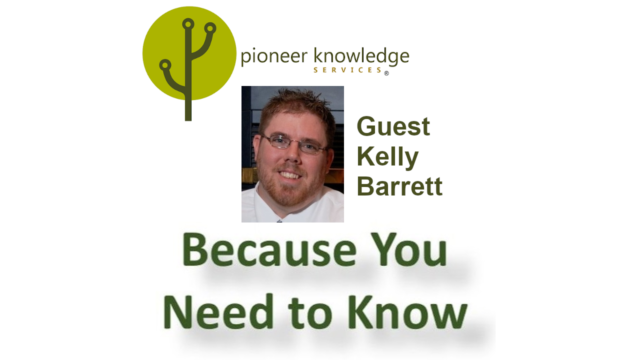
Organization Management Rhythm (part 4.2): Change management – Workflow and staff
This article is part 4.2 of a series of articles on Organization Management Rhythm.
In general, Organization Management Rhythm change requests can be grouped into three categories:
- The first is a temporary change to an existing event (e.g., the time of a meeting must be adjusted for one occurrence due to an external scheduling conflict).
- The second type of change is a permanent modification to an existing event (e.g., an event now requires video teleconferencing capabilities and the current meeting location is not properly equipped).
- The final type of Organization Management Rhythm change is the request to permanently add a new Organization Management Rhythm event.
Regardless of the type of request, all proposed changes should be submitted to the Organization Management Rhythm Manager (OMRM) via email or ticket. The request shall include the following information:
- Date of request
- Type of request (temporary change, permanent change, new event)
- Details of request
- Justification for request
- Supporting documentation as applicable (i.e., seven-minute drill)
- Suspense for answering request.

Organization Management Rhythm Manager (OMRM)
The OMRM will review the submitted Organization Management Rhythm change request and assess the nature of the request. The OMRM will take the appropriate actions based on the type of request (temporary change, permanent modification, add new event).
If the request is for a temporary change, the OMRM develops a temporary Organization Management Rhythm change course of action by reviewing the Organization Management Rhythm management products (calendar, information flow diagram, staff utilization matrix, and time-space matrix).
If the request entails a permanent change to the Organization Management Rhythm, the OMRM next evaluates if the request is for a modification to an existing event or a new event.
Permanent modification
For a permanent modification to an existing Organization Management Rhythm event, the OMRM must determine the impacts of the change not only on the specific event, but also on the overall Organization Management Rhythm. It is vital that the OMRM recognize the second and third order effects on the Organization Management Rhythm from modifying a single event. Therefore, the OMRM will evaluate the proposed modification to the event as follows:
- Does the request involve changes to the membership of the event? If yes, the OMRM determines impact on staff support by referencing the staff utilization matrix. This tool will indicate conflicts among events in terms of manning and give insight into the level of involvement of particular staff sections and special staff members.
- Does the request involve changes in the timing of the event? If yes, the OMRM determines the impact of the timing of the event using both the information flow diagram and calendar. This analysis should consider both the possibility of scheduling conflicts (two events occurring simultaneously with the same participants) and the disruption of event sequencing (ensuring events which feed other events are scheduled in chronological order with enough white space in between to deliver the required products).
- Does the request involve changes in the location of the event? If yes, the OMRM determines the impact of the new location of the event using the time-space matrix. This analysis should consider not only the availability of physical meeting spaces, but also video teleconferencing (VTC) resource limitations.
After analyzing the request utilizing the steps above, the OMRM will develop a change course of action (COA) and present it to the Chief of Information Operations (CIO).
Add new event
If the request is for a new event to be added to the Organization Management Rhythm, the OMRM must first determine if this is a valid request. This is done by comparing the request against existing events utilizing the seven-minute drill rollup.
If the OMRM determines that an existing event can be sufficiently modified to meet this new requirement, then a new Organization Management Rhythm event is not needed. In this case, the OMRM analyzes the impact of modifying the existing event using the same procedure outlined above.
If a new event is needed, the OMRM evaluates the submitted event for completeness by comparing it to the event template.
If the submitted event does not contain the requisite information, the requestor is notified and directed to modify the proposed event.
If the submitted event contains the required information, the OMRM determines the impact of the new event on the overall Organization Management Rhythm as follows:
- Determine impact on staff support by referencing the staff utilization matrix. This tool will indicate conflicts among events in terms of manning and give insight into the level of involvement of particular staff sections and special staff members.
- Determine the impact of the timing of the event using both the information flow diagram and calendar. This analysis should consider both the possibility of scheduling conflicts (two events occurring simultaneously with the same participants) and the disruption of event sequencing (ensuring events which feed other events are scheduled in chronological order with enough white space in between to deliver the required products).
- Determine the impact of the new location of the event using the time-space matrix. This analysis should consider not only the availability of physical meeting spaces, but also video teleconferencing (VTC) resource limitations.
After analyzing the request utilizing the steps above, the OMRM will develop a change COA and present it to the CIO.
Regardless of the type of Organization Management Rhythm change request, the OMRM will use the COA approved by the CIO to update the Organization Management Rhythm products.
Finally, the OMRM will brief the approved COA, including its method of implementation, at the next scheduled staff synch meeting.
Chief of Information Operations (CIO)
The CIO will review the Organization Management Rhythm change COA submitted by the OMRM and determine if the COA is acceptable.
If the CIO approves the COA, the OMRM is directed to update the Organization Management Rhythm products, and brief the COA at the next CIO sync meeting.
If the CIO rejects the COA, the OMRM is directed to refine the COA based on the CIO’s guidance.
The need to establish a good change management process is key.
Next part (part 5): Models.
Acknowledgements: Thank you to Tomi Antill, Keith Davis, Elise Keith from Lucid Meetings, JFHQ-C Leadership, and Kendra Albright from Kent State University, without whose support this series would not have been possible.
Header image source: U.S. National Archives, Public Domain.





